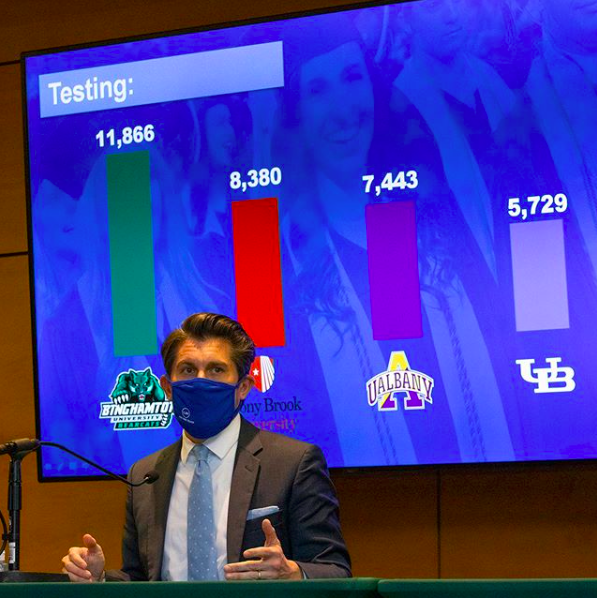Amid rising coronavirus cases both on and off campus, Binghamton University has moved all learning online for two weeks starting Thursday, according to a B-Line News Addition from BU President Harvey Stenger on Wednesday.
As of Oct. 7, Broome County reached 540 active cases while BU rose to 89 student cases comprised of campus-tested and self-reported accounts, nearing the 100 case threshold for a two-week period set out by New York State Gov. Andrew Cuomo. The previous two-week period, Sept. 12 to Sept. 25, saw 25 cases. SUNY Chancellor James Malatras joined Stenger at BU for a live press conference to address the rising COVID-19 cases. During the conference, Broome County Executive Jason Garnar emphasized that the majority of cases are not due to BU students.
“I believe what’s happened with the University’s numbers is because of what’s happening in the community, not the other way around,” Garnar said. “The average age of a positive person in Broome County is 40, so it’s not students on campus, but we support what the University is doing.”
In addition to the two-week pause, on-campus dining will be takeout only and all in-person extracurricular programs and other nonessential activities will be suspended, including club and intramural sports. All in-person athletic team activities will not take place and residence halls will remain open along with University Libraries and other services, as students are not being sent home. At the press conference, Stenger advised that student gatherings be limited to six persons.
According to the B-Line News Addition, Off Campus College Transport (OCCT) buses will move to a weekend schedule. However, Mack Conan, ‘19, public relations coordinator at OCCT, said that a reduced weekday schedule, along with a full weekend schedule, will be employed. OCCT is looking at ending its schedules earlier in order to reduce the spread of the virus. Details will be posted on the OCCT website once finalized.
During the press conference, Malatras commended BU’s COVID-19 testing efforts, stating that the University has done the most COVID-19 tests out of all the other large SUNY school testing centers.
Malatras also announced SUNY’s Monitor and Manage (M&M) project. “Monitoring” will consist of testing and transparency while “managing” will handle the crisis and the subsequent situations on all 64 SUNY campuses. This project comes after Malatras’ Sept. 25 SUNY-wide memo called for uniform penalties on students who break COVID-19 regulations.
“We are cracking down on parties and gatherings,” Malatras said. “Too often, more than not, I find instances of students violating those codes of conduct and that’s where a lot of our cases are coming from.”
On Monday, a mobile testing site opened at St. Patrick’s Church on 9 Leroy St. to provide Broome County with rapid supplemental testing.
The county has been designated as a “yellow zone” by Gov. Cuomo in his New Cluster Action Initiative, which aims to minimize the spread of COVID-19. Broome County is among four other New York counties which have experienced high-volume “clusters.” The Initiative requires places of worship to limit capacity to 50 percent. Mass gatherings, both indoor and outdoor, will be limited to a 25-person maximum, and businesses will remain open. Both indoor and outdoor dining will be limited to a four-person maximum per table.
Caitlin Rameas, a freshman majoring in integrative neuroscience, has been advised, along with her suite, to self-quarantine after possible exposure to someone with COVID-19.
“It has been very boring and I want to leave so badly, but I don’t want to potentially spread the virus,” Rameas said. “My social battery feels like it’s at zero and I have little motivation or energy to do anything.”
Byron Quinteros, a sophomore majoring in mathematics who lives off campus, said he is not concerned with the virus.
“I’m not as nervous because since I’m constantly in a more isolated environment and I take all the precautions,” Quinteros said. “I should be fine.”
Malatras expressed optimism over lowering the number of cases and returning to in-person classes.
“I think after two weeks, we’ll be in a much better position here,” Malatras said. “Again, it’s not a closure. It’s a pause.”



